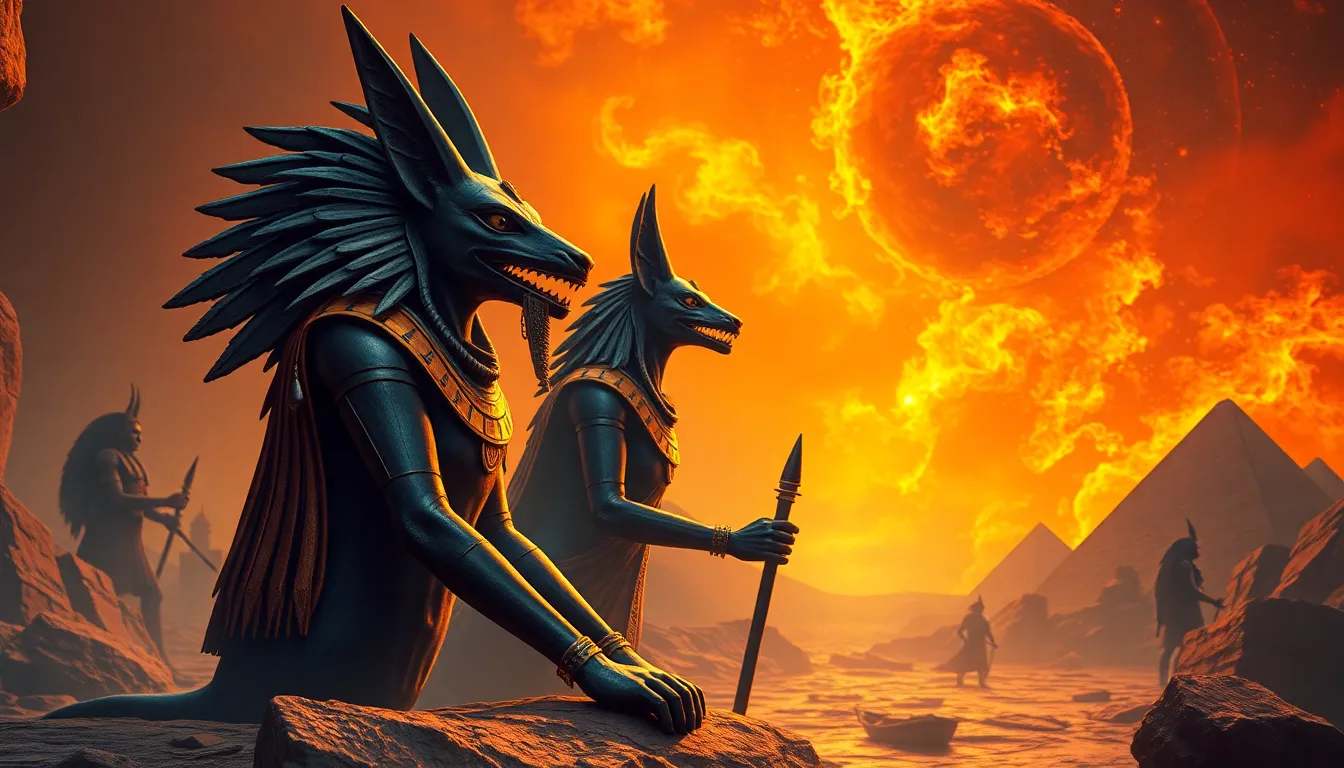The Guardians of the Underworld: Anubis and His Role
I. Introduction
Anubis, one of the most iconic deities in ancient Egyptian mythology, is often recognized as the god of mummification and the afterlife. His prominence in the Egyptian pantheon highlights the civilization’s deep fascination with death, burial practices, and the journey to the afterlife. Anubis played a crucial role in ensuring that the souls of the deceased transitioned safely into the next realm, making him an essential figure in Egyptian religious practices.
The purpose of this article is to explore Anubis’s historical background, his symbolic representations, his roles in the afterlife, and his lasting influence on modern culture.
II. Historical Background of Anubis
Anubis’s origins can be traced back to the early dynastic period of Egypt, around 3100 BCE. Initially depicted as a canine or a jackal, Anubis’s image evolved over the centuries as the beliefs and practices surrounding death and the afterlife became more complex.
Throughout various dynasties, Anubis was revered in different forms:
- In the Old Kingdom, he was primarily associated with mummification.
- During the Middle Kingdom, his role expanded to overseeing the afterlife.
- By the New Kingdom, Anubis was firmly established as the protector of the dead.
In relation to other deities, Anubis is often seen as a companion to Osiris, the god of the afterlife, and Isis, the goddess of motherhood and magic. Together, they formed a triad that represented the cycle of life, death, and rebirth.
III. Iconography and Symbols Associated with Anubis
Anubis is typically depicted as a man with the head of a jackal, symbolizing his role as a guardian of the dead. His black skin represents the color of the fertile soil of the Nile, symbolizing rebirth and regeneration.
Key symbols associated with Anubis include:
- Jackal: Representing vigilance and the guardian of graves.
- Scales: Used during the Weighing of the Heart ceremony.
- Ankh: Symbolizing life.
Artifacts and inscriptions featuring Anubis have been found in tombs, temples, and sarcophagi, reinforcing his significance in funerary practices. His image was believed to provide protection for the deceased on their journey to the afterlife.
IV. Anubis’s Role in the Afterlife
Anubis played a vital role in the mummification process, overseeing the embalming and preservation of the body, which was essential for the soul’s journey. His involvement ensured that the deceased would be protected and prepared for the afterlife.
One of the most significant ceremonies associated with Anubis is the Weighing of the Heart. In this ceremony, the heart of the deceased was weighed against the feather of Ma’at, the goddess of truth and justice. Anubis served as the guide during this process:
- If the heart was lighter than the feather, the deceased could enter the afterlife.
- If the heart was heavier, it was devoured by Ammit, the soul-eater.
As a protector of the deceased, Anubis ensured that those who had lived righteously would be granted eternal life, while those who had sinned would face judgment.
V. Anubis in Mythology and Literature
Anubis appears in various myths and stories throughout Egyptian literature. One key myth involves his assistance to Osiris, the god of the afterlife, in the resurrection of Osiris after his murder by Set. Anubis is portrayed as a loyal ally who helps prepare Osiris for his journey into the afterlife.
In addition to his interactions with Osiris, Anubis also engages with other deities, including:
- Isis: Providing support in the mourning and resurrection of Osiris.
- Thoth: The god of wisdom, who records the results of the Weighing of the Heart.
Anubis’s presence is prominent in ancient texts, including the Book of the Dead, where he is depicted as a guide for souls navigating the challenges of the afterlife.
VI. Anubis’s Influence on Modern Culture
The legacy of Anubis continues to resonate in contemporary culture. He has been depicted in various forms of media, including:
- Films: Movies such as “The Mummy” series showcase Anubis as a powerful figure in Egyptian mythology.
- Literature: Novels and graphic novels often feature Anubis in stories involving ancient Egyptian themes.
- Video Games: Many games incorporate Anubis as a character or a symbol within their narratives.
Furthermore, Anubis has become a symbol in modern spiritual practices, representing the journey of the soul and the importance of honoring the dead. The resurgence of interest in ancient Egyptian mythology has led to a deeper appreciation of Anubis and his significance in historical contexts.
VII. Comparative Analysis with Other Mythological Figures
When examining Anubis in the context of other mythological figures, similarities emerge with deities from various cultures who preside over the afterlife. For example:
- Hades: The Greek god of the underworld, who governs the realm of the dead.
- Cerberus: The three-headed dog that guards the gates of the underworld in Greek mythology.
Despite these similarities, there are differences in their roles and representations:
- Anubis serves as both a protector and guide, while Hades is more of a ruler.
- Cerberus is primarily a guardian, whereas Anubis is involved in the mummification and judgment processes.
This comparative analysis highlights the universality of themes related to death and the afterlife, revealing how different cultures address similar existential questions.
VIII. Conclusion
Anubis’s significance in ancient Egyptian belief systems cannot be overstated. As a guardian of the dead and a facilitator of the afterlife, he embodies the Egyptian understanding of death as a transition rather than an end. His legacy endures in modern culture, where he continues to captivate audiences and inspire spiritual practices.
Understanding ancient deities like Anubis offers valuable insights into the beliefs and values of past civilizations, enriching our appreciation of history and mythology. Through the lens of Anubis, we can reflect on the timeless themes of life, death, and the journey beyond.




